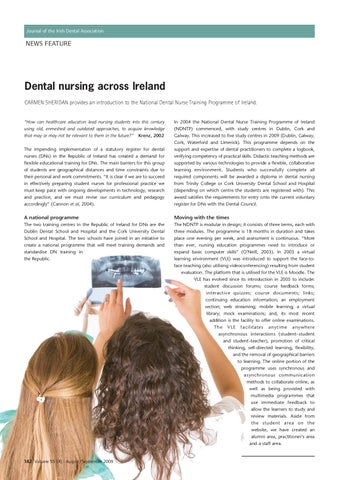Journal of the Irish Dental Association
NEWS FEATURE
Dental nursing across Ireland CARMEN SHERIDAN provides an introduction to the National Dental Nurse Training Programme of Ireland.
“How can healthcare educators lead nursing students into this century using old, enmeshed and outdated approaches, to acquire knowledge that may or may not be relevant to them in the future?” Krenz, 2002 The impending implementation of a statutory register for dental nurses (DNs) in the Republic of Ireland has created a demand for flexible educational training for DNs. The main barriers for this group of students are geographical distances and time constraints due to their personal and work commitments. “It is clear if we are to succeed in effectively preparing student nurses for professional practice we must keep pace with ongoing developments in technology, research and practice, and we must revise our curriculum and pedagogy accordingly” (Cannon et al, 2004).
In 2004 the National Dental Nurse Training Programme of Ireland (NDNTP) commenced, with study centres in Dublin, Cork and Galway. This increased to five study centres in 2009 (Dublin, Galway, Cork, Waterford and Limerick). This programme depends on the support and expertise of dental practitioners to complete a logbook, verifying competency of practical skills. Didactic teaching methods are supported by various technologies to provide a flexible, collaborative learning environment. Students who successfully complete all required components will be awarded a diploma in dental nursing from Trinity College or Cork University Dental School and Hospital (depending on which centre the students are registered with). This award satisfies the requirements for entry onto the current voluntary register for DNs with the Dental Council.
A national programme
Moving with the times
The two training centres in the Republic of Ireland for DNs are the Dublin Dental School and Hospital and the Cork University Dental School and Hospital. The two schools have joined in an initiative to create a national programme that will meet training demands and standardise DN training in the Republic.
The NDNTP is modular in design; it consists of three terms, each with three modules. The programme is 18 months in duration and takes place one evening per week, and assessment is continuous. “More than ever, nursing education programmes need to introduce or expand basic computer skills” (O’Neill, 2003). In 2005 a virtual learning environment (VLE) was introduced to support the face-toface teaching (also utilising videoconferencing) resulting from student evaluation. The platform that is utilised for the VLE is Moodle. The VLE has evolved since its introduction in 2005 to include: student discussion forums; course feedback forms; interactive quizzes; course documents; links; continuing education information; an employment section; web streaming; mobile learning; a virtual library; mock examinations; and, its most recent addition is the facility to offer online examinations. The VLE facilitates anytime anywhere asynchronous interactions (student–student and student–teacher), promotion of critical thinking, self-directed learning, flexibility, and the removal of geographical barriers to learning. The online portion of the programme uses synchronous and asynchronous communication methods to collaborate online, as well as being provided with multimedia programmes that use immediate feedback to allow the learners to study and review materials. Aside from the student area on the website, we have created an alumni area, practitioner’s area and a staff area.
182 Volume 55 (4) : August/September 2009
